St. George's Hall (Arts and Letters Club) National Historic Site of Canada
Toronto, Ontario

Interior view
© Agence Parcs Canada / Parks Canada Agency, D. Hamelin, 2005.
Address :
14 Elm Street, Toronto, Ontario
Recognition Statute:
Historic Sites and Monuments Act (R.S.C., 1985, c. H-4)
Designation Date:
2007-06-08
Dates:
-
1891 to 1891
(Construction)
-
1908 to 1908
(Significant)
-
1920 to 1920
(Significant)
Event, Person, Organization:
-
Edwards and Webster
(Architect)
-
Sproatt & Webster
(Architect)
Other Name(s):
-
St. George's Hall (Arts and Letters Club)
(Designation Name)
-
St. George's Hall (Arts and Letters Club)
(Other Name)
Research Report Number:
2005-058, 2005-122
Plaque(s)
Approved Inscription: 14 Elm Street, Toronto, Ontario
Since 1920, St. George's Hall has housed the renowned Arts and Letters Club. Founded in 1908 by a group of men involved in the arts, the Club has been a gathering place for artists and their patrons and has encouraged the organization of new artistic communities. With its long oak tables, timbered ceiling, and baronial fireplace, the Great Hall has provided a congenial setting for stimulating conversation and a venue for pageants, plays, musical evenings, and art exhibits. Filled with artwork and Club memorabilia, this building eloquently reflects the ideals and history of this important Canadian cultural institution.
Description of Historic Place
St. George’s Hall (Arts and Letters Club) National Historic Site of Canada is a three-storey brick and stone building with a steep-pitched roof. Located just west of Yonge St. in downtown Toronto the building, which has been home to the Arts and Letters Club since 1920, exhibits an eclectic blend of architectural styles that combine elements of Romanesque, Flemish and medieval architecture. Its symmetrical front façade is dominated by a prominent Romanesque Revival entranceway, while a Great Hall dominates the rear of the building. Official recognition refers to the building on its legal lot at the time of designation.
Heritage Value
St. George’s Hall (Arts and Letters Club) was designated a National Historic Site of Canada in 2007 because: since 1920, it has been the home of the Arts and Letters Club, originally a club for men working in or interested in arts, interpreted with creativity and humour; it has been a gathering place for artists (including painters, writers, musicians, architects and actors) and patrons of the arts, an important venue for artistic activity, and a catalyst for the organization of artistic communities; and, in its layout and decor, the building attests to the ideals and functions of the Club as well as its significance in Canada's cultural history.
The heritage value of St. George’s Hall (Arts and Letters Club) lies in its layout and décor, its function as a gathering place for artists and patrons of the arts, and its associations with the Arts and Letters Club. Constructed in 1891 for the St. George's Society, the building was renovated in 1920, when it became the headquarters for the Arts and Letters Club. The Club brought together individuals from a variety of disciplines – painters, writers, musicians, architects and actors, among others – as well as patrons of the arts. For some eighty-five years, St. George’s Hall has been a gathering place for people working in the arts, as well as an important venue for artistic activity. The well-preserved building attests to the significance of the Club in Canada’s cultural history.
Source: Historic Sites and Monuments Board of Canada, Minutes, December 2005.
Character-Defining Elements
The key elements that contribute to the heritage character of this site include: the location west of Yonge St. in the heart of downtown Toronto; the setting on a small urban lot with no surrounding property; the layout, décor, and architecture of the building which reflect the ideals of the club and its significance in Canada’s cultural history, including: the three-storey massing of the principal elevation set under a steep-pitched roof with two prominent steep-roofed dormer windows; the exterior walls of brick and stone construction; the symmetrical front façade, dominated by a central Romanesque Revival entranceway finished in stone featuring a wide arch flanked by heraldic crests, above which is set a stone panel bearing the name “St. George’s Hall”, and the frontispiece topped by a stepped gable that rises through two storeys to the roof; the decorative detailing including the metal stringcourses at the top of the first and second storeys, the plate tracery on the front gable and the steeped gables at each end of the roof; the Great Hall at the rear of the building, which rises two storeys, with its single buttresses pointed Gothic Revival windows with plate tracery, and its steeply pitched roof with dormer windows; the sophisticated interior with its ornately wood-panelled vestibule that opens to various rooms and gathering places; surviving evidence of the original interior configuration, features, and finishes including the first-floor Lounge and “Lamps Room,” the Great Hall with its cathedral ceiling, the Library, the Club Archives, and the third floor studio.